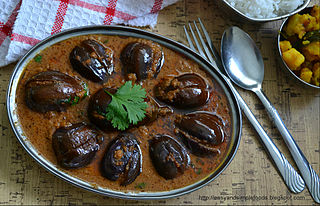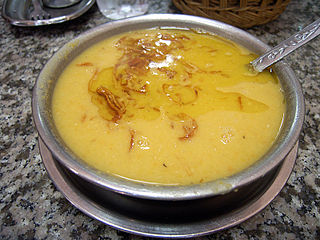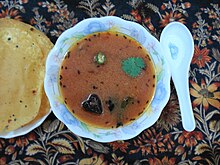Indian cuisine consists of a variety of regional and traditional cuisines native to the Indian subcontinent. Given the diversity in soil, climate, culture, ethnic groups, and occupations, these cuisines vary substantially and use locally available spices, herbs, vegetables, and fruits.

Mulligatawny is a soup which originated from South Indian cuisine. The name originates from the Tamil words miḷagu, and taṇṇi ; literally, "pepper-water". It is related to the dish rasam.

Sambar, known as Kuzhambu in TamilNadu, is a lentil-based vegetable stew, cooked with pigeon pea and tamarind broth. It is popular in South Indian, Sri Lankan and Maldivian cuisines. The stew has been adapted into Burmese cuisine as a popular accompaniment to Burmese curries.

Sadya is a meal of Kerala origin and of importance to all Malayalis, consisting of a variety of traditional vegetarian dishes usually served on a banana leaf in Kerala as lunch. Sadya means banquet in Malayalam. Sadya is typically served as a traditional feast for Onam, the state festival of Kerala and Vishu.

Tamil cuisine is a culinary style of Tamil people originating in the southern Indian state of Tamil Nadu and neighboring Sri Lanka. Meats, along with rice, legumes, and lentils, are also popular. Dairy products and tamarind are used to provide sour flavors. On special occasions, traditional Tamil dishes are served in a traditional manner, using banana leaves in place of utensils. After eating, the banana leaves are then used as a secondary food for cattle. A typical breakfast meal consists of idli or dosa with chutney. Lunch includes rice, sambar, curd, kuzhambu, and rasam.

Rajasthani cuisine is the cuisine of the Rajasthan state in North West India. It was influenced by various factors like the warlike lifestyles of its inhabitants, the availability of ingredients in an arid region and by Hindu temple traditions of sampradayas like Pushtimarg and Ramanandi. Food that could last for several days and could be eaten without heating was preferred. Scarcity of water and fresh green vegetables have all had their effect on the cooking. Signature Rajasthani dishes include Dal Baati Churma, Panchratna Dal, Papad ro Saag, Ker Sangri, Gatte ro Saag. It is also known for its snacks like Bikaneri bhujia, Mirchi bada and Kanda kachauri. Other famous dishes include Dal Baati, malaidar special lassi (lassi) and Lashun ki chutney, Mawa lassi from Jodhpur, Alwar ka mawa, Malpauas from Pushkar and rasgulla from Bikaner, "paniya"and "gheriya" from Mewar. Originating for the Marwar region of the state is the concept Marwari Bhojnalaya, or vegetarian restaurants, today found in many parts of India, which offer vegetarian food of the Marwari people. The history also has its effect on the diet as the Rajputs preferred majorly a non-vegetarian diet while the Brahmins, Jains, Bishnois and others preferred a vegetarian diet. So, the state has a myriad of both types of delicacies.

Idiyappam, also known as string hopper, indiappa, noolputtu, noolappam, or ottu shavige, is a string hopper dish originating from southern India. It consists of rice flour pressed into noodles, laid into a flat disc-like shape and steamed. The dish also spread to Southeast Asia, where it is called putu mayam in Malaysia and Singapore, and putu mayang in Indonesia.
Udupi cuisine is a cuisine of South India. It forms an important part of Tuluva cuisine and takes its name from Udupi, a city on the southwest coast of India in the Tulunadu region of the state of Karnataka. Udupi cuisine is strictly vegetarian and has its origin in the Udupi Sri Krishna Matha founded by Madhvacharya. The cuisine was developed by Madhva Brahmins to offer different kinds of food to Krishna at the Udupi Krishna Temple. Hence, Udupi cuisine is also synonymously known as Madhva cuisine.

Kadhi, or karhi, is a popular dish mainly consumed in South Asia. It consists of a thick gravy or soup based on gram flour, and it may contain vegetable fritters called pakora, which include dahi (yogurt) for a sour taste. It is often eaten with cooked rice or roti. Varieties of kadhi include those from Rajasthan, Maharashtra, Gujarat, Punjab, and Sindh, all of which are located in present-day India and Pakistan.

Bisi bele bhath or bisi bele huliyanna (ಬಿಸಿಬೇಳೆಹುಳಿಯನ್ನ) is a spicy, rice-based dish with origins in the state of Karnataka, India. It is said to have originated in the Mysore Palace and it took a 100 years for the dish to come out of the palace kitchens and another 200 years to spread across the state of Karnataka.

Ragi mudde, ragi sangati or kali, colloquially simply referred to as either mudde or hittu which means 'lump' or 'dough' is a finger millet swallow dish of India in the state of Karnataka and Andhra Pradesh. In Tamil Nadu, especially in western Tamil Nadu, it is also called ragi kali. Ragi mudde is the main food in Kolar, Mandya, Hassan, Mysore, Tumkur districts in Karnataka and Rayalaseema Region in Andhra Pradesh. A similar variation known as Dhindo is also eaten in Northeast India, Nepal and Bhutan. In Uttarakhand and Himachal Pradesh in northern India, a similar variation is known as Baadi and Baari respectively.
Konkani cuisine is the cuisine of the Saraswat Brahmins from the Konkan region on the western coast of India. Konkani cuisine differs within the Saraswat Brahmin subsects and within the Konkan-Canara region. Konkani cuisine originally hails from the Konkan region including Uttara Kannada, Udupi district, Dakshina Kannada, Damaon, and Goa, India. Konkani cuisine is popular served in many restaurants throughout the western coast of India, and especially in the cities of Bombay and Bangalore. Each variation has its unique flavour and makes uses of different vegetables and fruits available in the region. Konkani cuisine is usually pesco-vegetarian, except acharyas and purohits who follow a strictly saatvik vegetarian diet. According the Konkani folklore, fish, meats are regarded as sea vegetables. Historically, they have refrained from eating any terrestrial animals in general.
Mangalorean bangude masala is a dish made of cooked mackerel fish served in households and eateries along the Karavalli coastline, in south-western India. This dish is popular in the coastal districts of Dakshina Kannada and Udupi. Mackerel is common along the Arabian Sea coastline, and is widely consumed in the states of Kerala, Karnataka, Goa and Maharashtra. Bangude (ಬಂಗುಡೆ), in Tulu, Konkani, Kannada and in the various dialects spoken along the Konkan/Karavalli coast, means mackerel.

Kuḻambu, is a common dish in Tamil Nadu and Sri Lankan cuisines, and is a tamarind-based dish that can include a variety of meat, vegetables, and in some cases, dal.

Andhra cuisine, culturally known as Telugu cuisine, is a cuisine of India native to the state of Andhra Pradesh and is the culinary style of Telugu people. It is generally known for its tangy, hot, and spicy taste.

Malaysian Indian cuisine, or the cooking of the ethnic Indian communities in Malaysia, consists of adaptations of authentic dishes from India, as well as original creations inspired by the diverse food culture of Malaysia. Because the vast majority of Malaysia's Indian community are of South Indian descent, and are mostly ethnic Tamils who are descendants of immigrants from a historical region which consists of the modern Indian state of Tamil Nadu and Sri Lanka's Northern Province, much of Malaysian Indian cuisine is predominantly South Indian inspired in character and taste. A typical Malaysian Indian dish is likely to be redolent with curry leaves, whole and powdered spice, and contains fresh coconut in various forms. Ghee is still widely used for cooking, although vegetable oils and refined palm oils are now commonplace in home kitchens. Before a meal it is customary to wash hands as cutlery is often not used while eating, with the exception of a serving spoon for each respective dish.

In Indian cuisine, dal, paruppu, or pappu are dried, split pulses that do not require soaking before cooking. India is the largest producer of pulses in the world. The term is also used for various soups prepared from these pulses. These pulses are among the most important staple foods in South Asian countries, and form an important part of the cuisines of the Indian subcontinent.

Lentil soup is a soup with lentils as its main ingredient; it may be vegetarian or include meat, and may use brown, red, yellow, green or black lentils, with or without the husk. Dehulled yellow and red lentils disintegrate in cooking, making a thick soup. It is a staple food throughout Europe, Latin America and the Middle East.

Medu vada is a South Indian breakfast snack made from Vigna mungo. It is usually made in a doughnut shape, with a crispy exterior and soft interior. A popular food item in South Indian cuisine it is generally eaten as a breakfast or a snack.




















